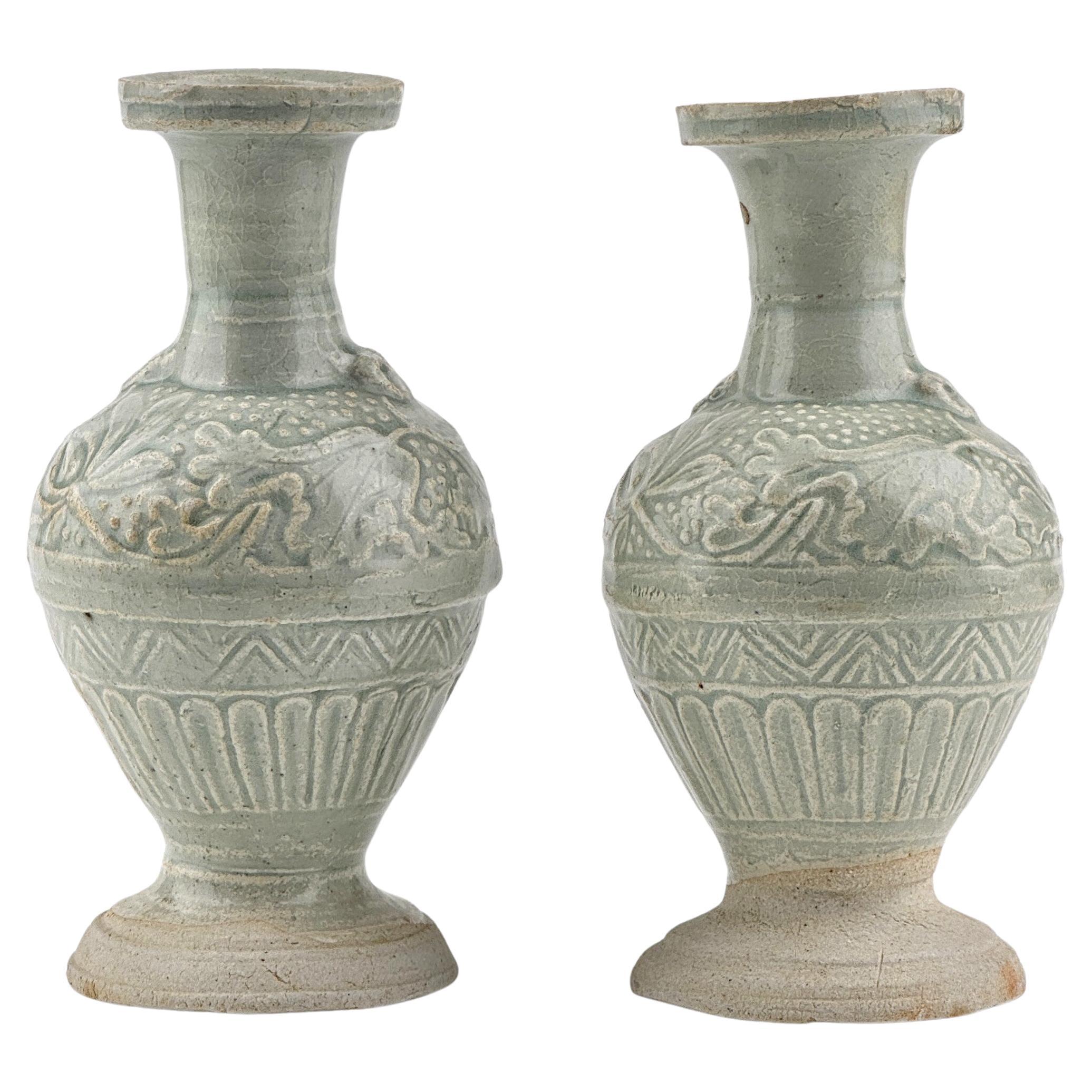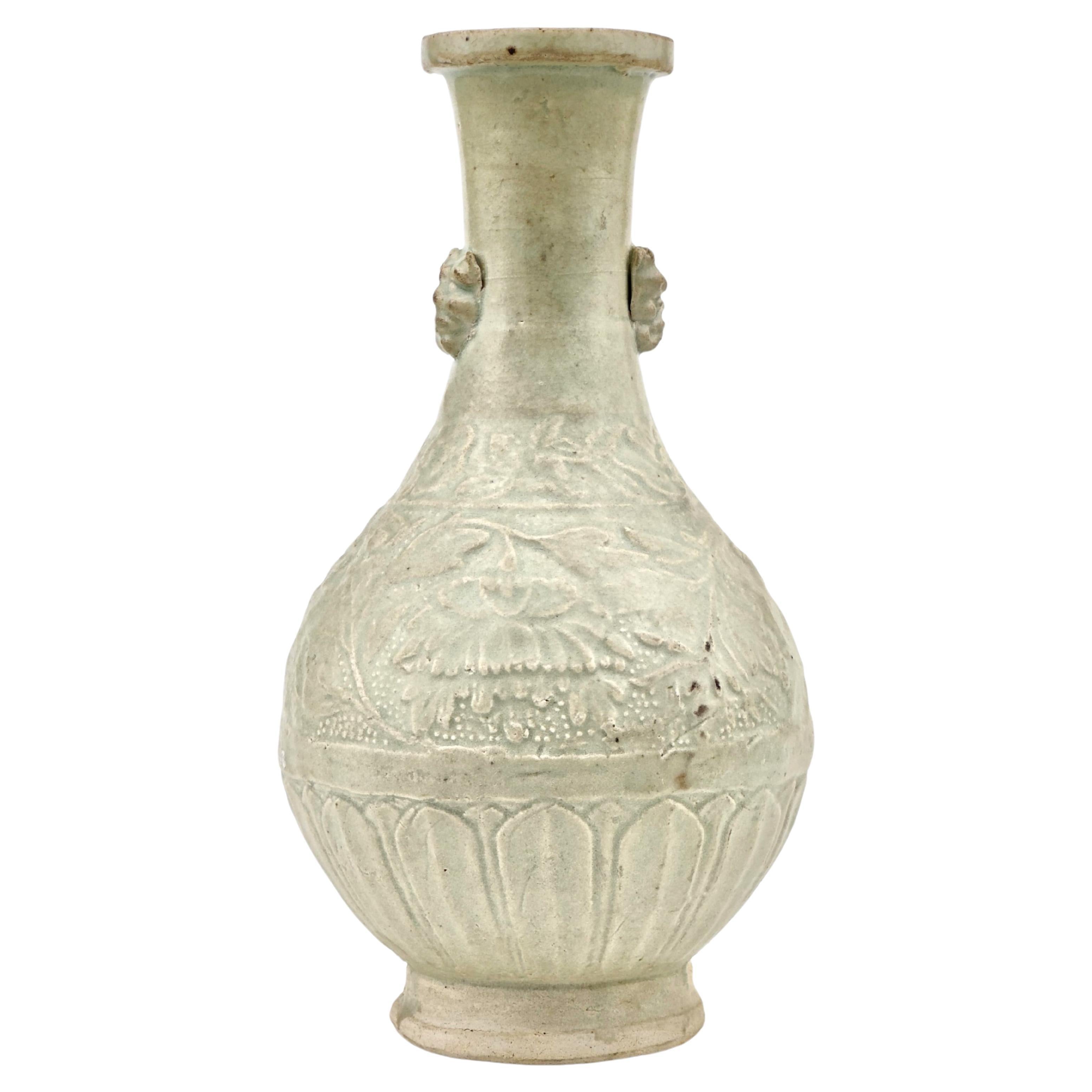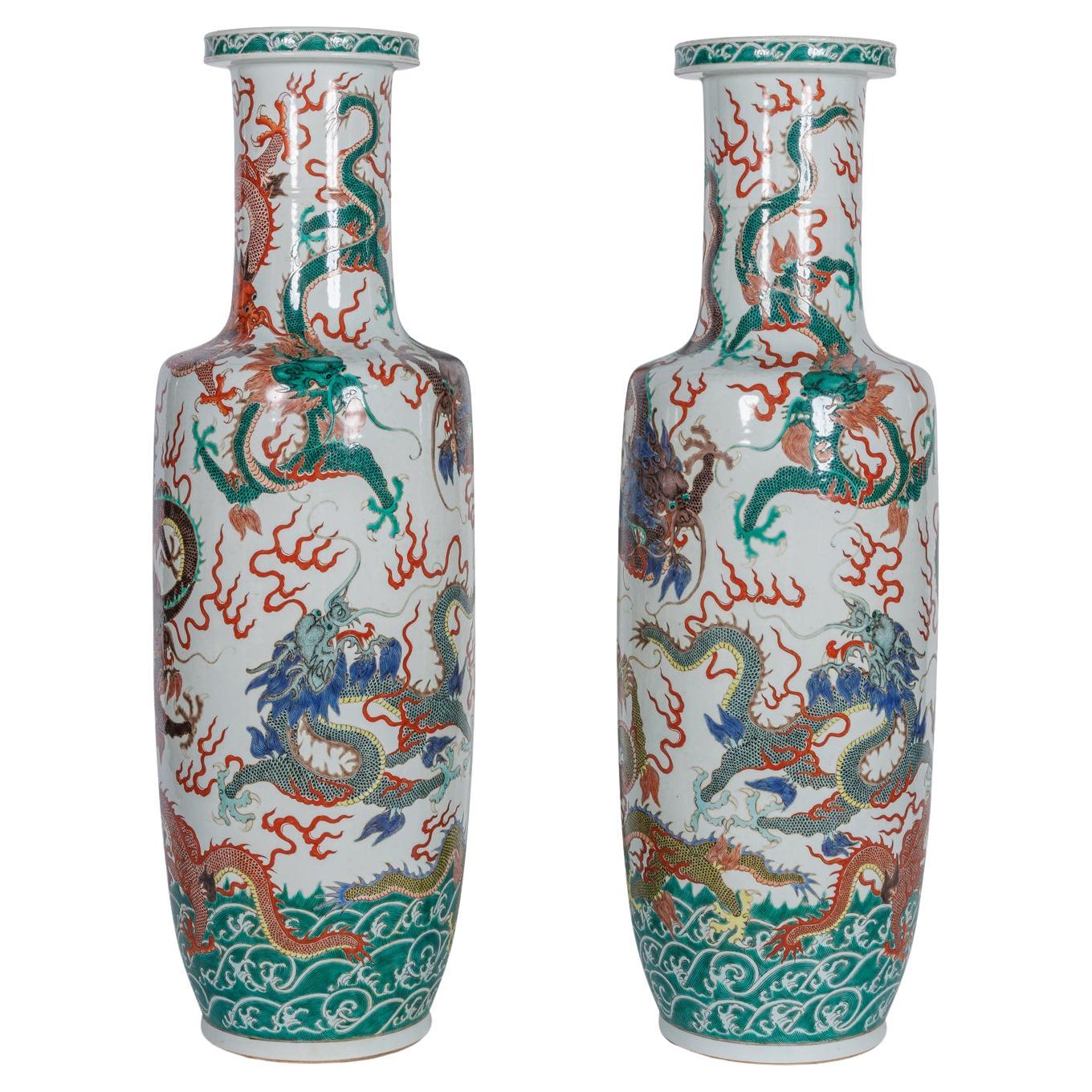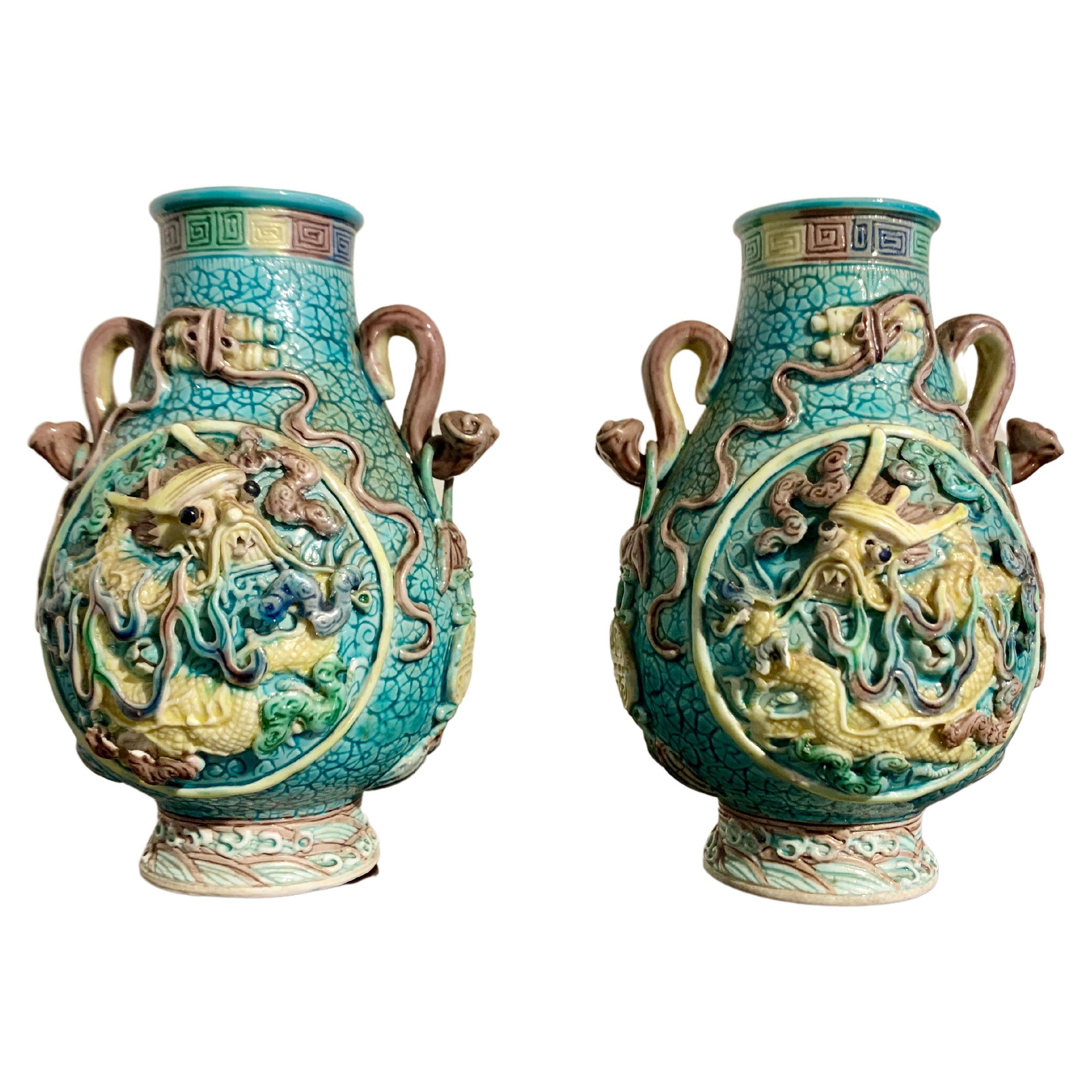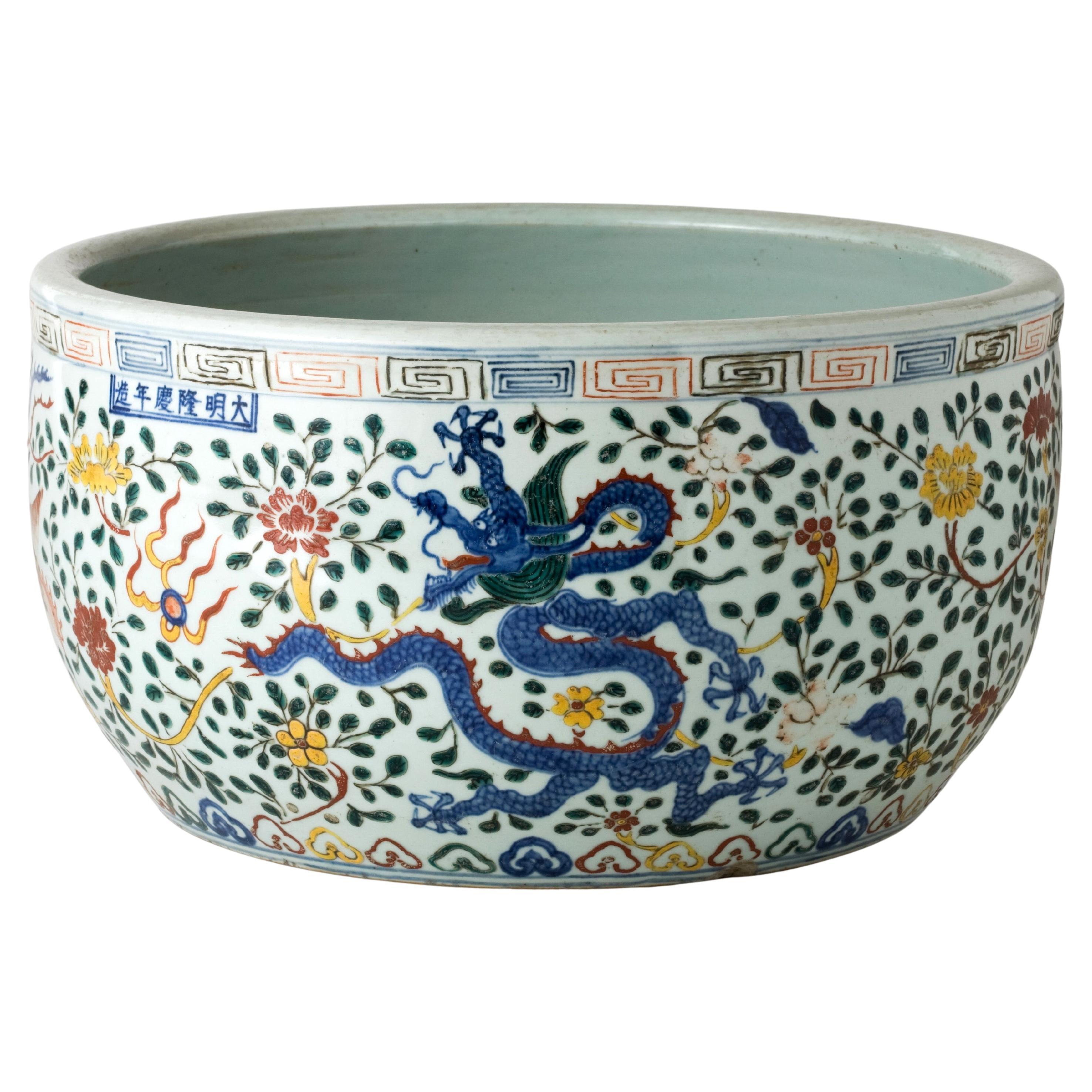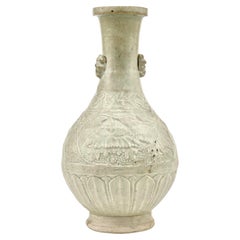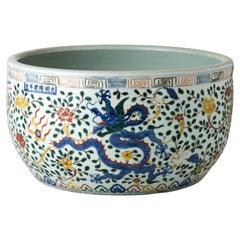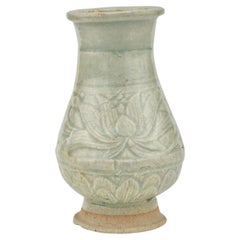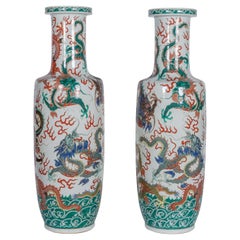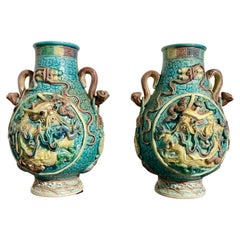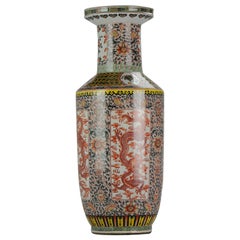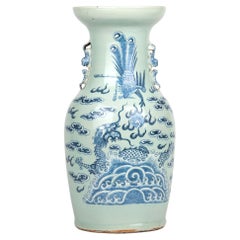Items Similar to White Ware with two dragons, Yuan Dynasty, 13-14th century
Want more images or videos?
Request additional images or videos from the seller
1 of 14
White Ware with two dragons, Yuan Dynasty, 13-14th century
$1,245
$2,49050% Off
£954.14
£1,908.2850% Off
€1,096.62
€2,193.2450% Off
CA$1,748.66
CA$3,497.3350% Off
A$1,957.08
A$3,914.1550% Off
CHF 1,024.46
CHF 2,048.9250% Off
MX$23,774.94
MX$47,549.8850% Off
NOK 13,008.04
NOK 26,016.0850% Off
SEK 12,275.31
SEK 24,550.6150% Off
DKK 8,182.70
DKK 16,365.4050% Off
About the Item
This vase is made from a type of low-fired, porous clay and features a crackled glaze. It bears resemblance to the renowned funerary vases and covers adorned with applied decorations.
Period : Yuan Dynasty(1271-1368)
Type : vase
Medium : Qingbai Ware
Size : 20 cm(Height), 7cm(Mouth Diameter)
Provenance : Acquired in late 1990s, Hongkong
Reference :
1) Smithsonian National Museum of Asian Art - Accession Number F1984.18
2) Ashmolean Museum, Oxford - Accession no.LI1301.295
* Qingbai Ware
Qingbai ware, which translates to "blue-white ware," is a type of Chinese porcelain that was made at the Jingdezhen and other kilns in the porcelain-producing regions of China, primarily during the Song dynasty (960–1279) and continuing into the Yuan dynasty (1271–1368). It is known for its translucent quality and the pale blue-green glaze that characterizes most of its pieces.
The qingbai glaze was achieved using a small amount of iron in a reduction-fired atmosphere, which produced the subtle blue-green tint. The body of qingbai ware is typically made of a fine, white porcelain that is often referred to as 'artificial jade' due to its resemblance to the esteemed stone. The thinness of the body and the high firing temperatures used contributed to the translucent quality of the finished product.
Qingbai ware includes a range of items such as bowls, cups, vases, and ewers. The designs are usually simple and elegant, with an emphasis on the graceful lines and form of the objects. Decorative motifs, when present, are often incised, carved, or molded in relief and can include floral patterns, dragons, phoenixes, and other symbolic elements drawn from Chinese culture.
Over time, the technology and techniques used to produce qingbai ware evolved, leading to innovations in glaze and decoration that would influence later types of Chinese porcelain. Despite these changes, qingbai ware remains a distinguished example of the potters' art in Song and Yuan China, reflecting the refined aesthetic and cultural values of the period.
- Dimensions:Height: 7.88 in (20 cm)Diameter: 2.76 in (7 cm)
- Materials and Techniques:
- Place of Origin:
- Period:
- Date of Manufacture:14th century
- Condition:Minor fading.
- Seller Location:seoul, KR
- Reference Number:1stDibs: LU9577239080662
About the Seller
4.8
Gold Seller
Premium sellers maintaining a 4.3+ rating and 24-hour response times
Established in 1999
1stDibs seller since 2023
38 sales on 1stDibs
Typical response time: <1 hour
- ShippingRetrieving quote...Shipping from: seoul, Korea South
- Return Policy
Authenticity Guarantee
In the unlikely event there’s an issue with an item’s authenticity, contact us within 1 year for a full refund. DetailsMoney-Back Guarantee
If your item is not as described, is damaged in transit, or does not arrive, contact us within 7 days for a full refund. Details24-Hour Cancellation
You have a 24-hour grace period in which to reconsider your purchase, with no questions asked.Vetted Professional Sellers
Our world-class sellers must adhere to strict standards for service and quality, maintaining the integrity of our listings.Price-Match Guarantee
If you find that a seller listed the same item for a lower price elsewhere, we’ll match it.Trusted Global Delivery
Our best-in-class carrier network provides specialized shipping options worldwide, including custom delivery.More From This Seller
View AllTwo white ware vases with flower design, Yuan Dynasty, 14th century
Located in seoul, KR
Porcelain with transparent pale-green (qingbai-type) glaze with flower, leaves and lotus design of typical yuan dynasty.
Period : Yuan Dynasty(1271-1368)
Type : Baluster vase
Medium...
Category
Antique 15th Century and Earlier Hong Kong Antiquities
Materials
Ceramic, Porcelain
$2,392 Sale Price
20% Off
A Carved White Ware 'peony' vase, Song-Yuan dynasty
Located in seoul, KR
The vase is raised on a slightly splayed foot and flanked on the tall cylindrical neck by a pair of mask handles. The body is molded with lotus scroll pattern between a floral scroll...
Category
Antique 15th Century and Earlier Hong Kong Antiquities
Materials
Ceramic, Porcelain
$1,560 Sale Price
60% Off
A Rare Large Wucai Dragons and Phoenix Jar, Ming dynasty Longqing Emperor
Located in seoul, KR
The blue dragon and the red dragon are depicted in dynamic postures, each extending its claws to grasp a ruyi pearl (如意珠). The phoenix is adorned with flowing feathers and delicate c...
Category
Antique 16th Century Hong Kong Ming Antiquities
Materials
Ceramic
$10,500 Sale Price
30% Off
White Ware Moulded Baluster Form, Yuan Dynasty, 14th century
Located in seoul, KR
This vase is made from a type of low-fired, porous clay and features a crackled glaze. It bears resemblance to the renowned funerary vases and covers adorned with applied decorations...
Category
Antique 15th Century and Earlier Hong Kong Antiquities
Materials
Ceramic, Porcelain
$950 Sale Price
50% Off
A Qingbai Carved Meiping Porcelain, Song Dynasty
Located in seoul, KR
The vase exhibits a finely crafted structure, characterized by its wide shoulders and elongated, tapering sides, topped with a compact, ribbed cylindrical neck. Its exterior is adorn...
Category
Antique 15th Century and Earlier Hong Kong Ceramics
Materials
Ceramic, Porcelain
$6,965 Sale Price
65% Off
Longquan Celadon 'Dragon' Jar and Cover, Song Dynasty(1127–1279)
Located in seoul, KR
A similar jar with a cover, part of the Avery Brundage collection at the Asian Art Museum in San Francisco, is featured in Mary Tregear's "Song Ceramics" (London, 1982, plate 286). T...
Category
Antique 15th Century and Earlier Hong Kong Antiquities
Materials
Celadon
$6,950 Sale Price
50% Off
You May Also Like
A Highly Rare Pair of Monumental Qing Dynasty Rouleau Porcelain "Dragon" Vases
Located in Queens, NY
A Highly Rare Pair of Monumental Qing Dynasty Rouleau Porcelain "Dragon" Vases
A Masterful Display of 19th Century Chinese Artistry:
The mid-19th century Qing Dynasty marked a period of artistic innovation and imperial grandeur, as exemplified by this rare and monumental pair of Rouleau vases. These exceptional porcelain works, notable for their commanding size and vibrant palette, are a testament to the unparalleled craftsmanship that flourished during this era. Embellished with a dynamic tableau of dragons rendered in bold hues of red, green, blue, brown, and yellow, these vases embody both artistic brilliance and the deep cultural symbolism woven into Chinese decorative arts.
Artistic Excellence and Symbolism:
At the heart of these magnificent vases lies a visual narrative that channels the power and mystique of the dragon, a central motif in Chinese culture symbolizing imperial authority, strength, and cosmic energy. The intricate depiction of dragons in motion, intertwined amidst stylized ocean waves, conveys a sense of fluidity and dynamic movement. Each color used—the crimson reds, verdant greens, striking blues, earthy browns, and golden yellows—has been meticulously applied, reflecting a mastery of the high-fired, polychrome enameling techniques perfected during the Qing Dynasty.
The Rouleau form, with its cylindrical body, short neck, and slightly flared mouth, was a favored shape for large-scale vases in the 18th and 19th centuries. The form’s structured elegance allowed for expansive decorative panels, serving as an ideal canvas for intricate, multi-layered designs. This pair demonstrates how artisans skillfully balanced the flowing movement of the dragons with the rhythmic motifs of waves, resulting in a harmonious composition that engages the viewer from every angle.
Craftsmanship and Technique:
These vases represent the pinnacle of porcelain artistry achieved under the Qing Dynasty, showcasing techniques that reflect centuries of refined craftsmanship. The precision in the application of overglaze enamels and the expert manipulation of kiln temperatures to achieve vibrant and consistent coloration are indicative of the expertise within the imperial kilns. The dragons' scales, rendered with remarkable detail, create a textured effect that contrasts beautifully with the smooth, undulating waves, enhancing the three-dimensional quality of the design.
The depth of color and the crisp delineation of each element point to a rigorous and time-intensive process. These qualities signify the involvement of highly skilled artisans who adhered to the imperial standards set by the royal court, ensuring that each piece was a fitting representation of the empire’s wealth and cultural prowess.
Historical and Cultural Significance:
Vases of this caliber were not merely decorative; they were imbued with profound symbolic meaning and often commissioned for imperial use or gifted as prestigious diplomatic offerings. The dragon motif, deeply embedded in Chinese folklore and philosophy, was associated with the emperor himself—known as the "Son of Heaven"—and symbolized his divine right to rule. These vases also reflect the Qing Dynasty's flourishing export trade and the global fascination with Chinese porcelain during the 19th century. European collectors and royal patrons prized such pieces for their artistry and the exoticism they represented, contributing to a legacy that elevated Chinese porcelain to a revered status in the annals of decorative art history.
Provenance and Collectability:
The extraordinary scale, exceptional craftsmanship, and rarity of this pair establish them as museum-quality works. Such vases would have held a place of honor in a palace or wealthy estate, reflecting not only the owner’s status but also an appreciation for the profound cultural and artistic traditions of China. Their provenance—potentially tied to an imperial commission or significant historical collection—underscores their importance as objects of study and admiration.
Provenance:
Private American Collection, acquired in London, circa 1905.
Thence by descent to the current owners
Solomon Treasure...
Category
Antique Mid-19th Century Chinese Qing Ceramics
Materials
Porcelain
Pair Small Chinese Dragon Vases, Molded and Glazed Porcelain, Republic Period
Located in Austin, TX
A fabulous pair of small Chinese molded and glazed biscuit ware porcelain dragon vases with loose eyes and apocryphal Qianlong mark, Republic Period, circa 1920, China.
The small ...
Category
Vintage 1920s Chinese Qing Ceramics
Materials
Porcelain
China 20th Century Dragon Vase of Chinese Porcelain, Mid-20th Century
Located in Amsterdam, Noord Holland
A very nicely decorated Vase with a scene of red dragons on a black and yellow ground.
Absolute top quality painting of the 20th century.
14-6-19-6-2
Overall condition; Ver...
Category
20th Century Chinese Ceramics
Materials
Porcelain
$5,669 Sale Price
20% Off
Chinese Large Qing Celadon Ground Porcelain Vase with Dragon & Phoenix Bird
Located in Bishop's Stortford, Hertfordshire
A large and impressive antique Chinese Qing Dragon & Ho Ho Bird chasing a flaming pearl decorated vase dating from the 19th century. This finely potted porcelain vase is of large bal...
Category
Antique 19th Century Chinese Qing Ceramics
Materials
Porcelain
Large Chinese Porcelain Water Basket Swatow Style Dragons, 19th Century
Located in Amsterdam, Noord Holland
A very nicely decorated Water Basket/Crrier. White and blue. 19C in the style of Swatow ware. Nice scene of dragons.
Additional information:
Material: Porcelain & Pottery
Region of ...
Category
Antique 19th Century Chinese Qing More Dining and Entertaining
Materials
Porcelain
$1,344 Sale Price
20% Off
Chinese Blue and White Dragon Meiping Vase
Located in Chicago, IL
Chinese blue-and-white porcelain has inspired ceramists worldwide since cobalt was first introduced to China from the Middle East thousands of years ago. Made in Beijing, this contem...
Category
21st Century and Contemporary Chinese Chinese Export Ceramics
Materials
Porcelain
More Ways To Browse
14th Century Furniture
Antique China Ware
Green Ware
Song Dynasty Furniture
Asian Carved Dragons
Dragon Blue And White
Ceramic Dragons
Dragon Stone
Song Porcelain
Dragon And Phoenix
Iron Dragon
Song Dynasty Vase
Thin Porcelain Chinese
Chinese Blue And White Dragon
Jade Dragon
Song Dynasty Porcelain
Green Dragon Vase
Blue And White Porcelain Dragon
